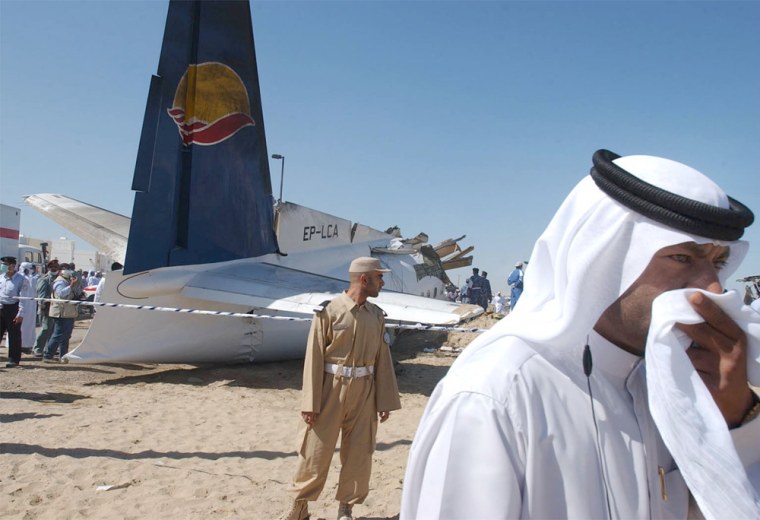An Iranian plane carrying mostly foreign workers crashed Tuesday as it approached Sharjah airport in the United Arab Emirates, killing 43 people aboard, officials said. Three survivors were hospitalized.
“Two of the survivors are in a critical condition. The third is conscious and stable,” said Mohammed Musalaheddin, an orthopedics physician at Sharjah’s Al Qassimi hospital.
The Kish Air Fokker-50, flying to Sharjah from the Iranian island of Kish in the Gulf, crashed at 11:40 a.m. in an open area about two miles from the airport, said Ghanem al-Hajiry, director general of civil aviation and the Sharjah Airport Authority.
No one on the ground was hurt, Al-Hajiry said. Witnesses said the plane crashed on a road near an upper-class residential neighborhood, about 660 feet from the nearest homes.
Rescue workers in white robes searched for survivors in the burning wreckage. Helicopters landed near the scene with rescue workers to remove victims.
About 30 charred bodies lay in rows, covered with red blankets near the wreckage. One was of an infant girl.
Later, a crane picked through the charred debris, lifting chunks of wreckage. Only the tail and cockpit area of the plane were recognizable.
The cause of the crash was not known, al-Hajiry said. An Internet search based on the plane’s tail number indicated the Fokker-50 was 11 years old — far newer than most passenger planes in Iran’s aging fleet — and was delivered to Kish Air in 2002.
Mohammed al-Ghaith, another senior Civil Aviation official, said the pilots had not sent out an emergency call, which could indicate a malfunction. The plane’s flight data and cockpit voice recorders had been found, he said, and that an Iranian delegation was en route to take part in the investigation.
In Tehran, Kish Airline officials refused to comment.
Foreigner workers onboard
Of the 46 people aboard, 43 were killed, said Col. Saleh Ali al-Mutawaa, general director of Sharjah Police. He identified them as 19 Iranians, 12 Indians, four Egyptians, two Filipinos, two Algerians, one Syrian, one Chinese, one Nigerian and one Bangladeshi.
Three crash victims were being treatment at al-Qasimi hospital in Sharjah, an emergency room attendant told The Associated Press. Two were in critical condition, he said, while the Emirates’ official news agency, WAM, said the third was stable.
Al-Mutawaa said two of the victims at al-Qasimi hospital were Filipinos, and the third was an Iranian.
Two people who survived the crash died after being taken to hospitals, WAM reported.
Flights to nearby destinations such as Kish mainly carry foreigners — particularly Asian workers, including Indians, Pakistanis and Filipinos, who make up the bulk of the Emirates’ work force — to exit and return in order to remain within Emirati visa requirements. Foreigners whose visas are expiring need to exit and re-enter on a new visa, which takes two or three days to process.
Kish is a favorite destination for those renewing their travel documents because tickets are cheap and Iranian visas aren’t needed. Cheap hotels cater to such travelers.
Kish, one of the three free trade zones in Iran, is the Islamic Republic’s attempt to lure tourism and foreign exchange. The island operates as a kind of bridge between the conservative morality of mainland Iran and the bikini-and-booze freedoms in parts of the United Arab Emirates, 60 miles away.
Unlike the mainland, there are no rules to limit the mingling of unrelated men and women. They even get together in wet suits for scuba diving classes — impossible elsewhere under Iran’s strict dress codes. On the streets, women go without the long coat worn across Iran.
At the airport, Abdel Rasoul al-Majidy said his 65-year-old father-in-law was supposed to be arriving on the flight. “We don’t know what’s going on. All we know is that my father-in-law was arriving today and then we heard of this plane crash,” he said.
His wife, Fawziyah, began screaming hysterically at airport officials: “Where’s my father? Where’s my father? Bring him to me.”
Kish Airline had a fleet of four medium-range, Russian-built Tu-154M jets on domestic and international flights and four short-range Fokker-50 turboprops, according to the company’s Web site.
History of accidents
Iran has a history of air accidents, often blamed on badly maintained planes. In June, an Iranian military C-130 transport plane crashed outside Tehran, killing all seven people aboard. In February, a Russian-made Ilyushin-76 crashed in southeastern Iran, killing all 275 aboard.
In Belarus in September, a Tu-154 belonging to Kish Air on a Tehran-Minsk-Copenhagen flight went off course while making its approach at the Minsk-2 airport, striking trees. None of the 40 people aboard was hurt.
In 1995, an Iranian flight attendant hijacked a Kish Air Boeing 707 to Israel during a flight from Tehran. The plane was returned to Tehran with 174 passengers and crew.
Last month, a top Iranian aviation official asked the United States to lift sanctions on its airline industry as a humanitarian gesture so the country can buy spare parts for its planes.
Tehran blames many of its crashes on the sanctions, saying they have prevented the country from repairing and replacing a fleet that includes many Russian-made planes. Iran has complained of trouble buying European-made planes as well, because some parts and engines are built in the United States.
